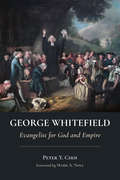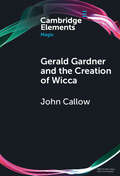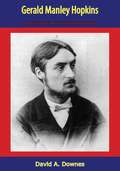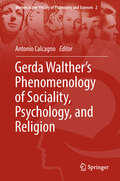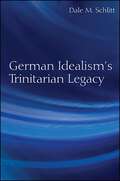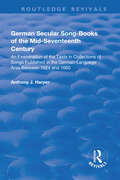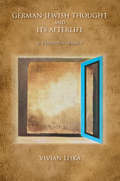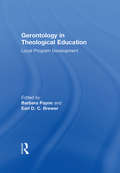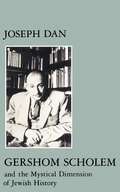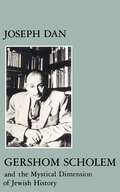- Table View
- List View
George Washington Carver: Man's Slave Becomes God's Scientist
by David R. Collins Joe Van SeverenGeorge Washington Carver recounts the story of his life and shares his faith and dependence upon his Savior, Jesus Christ.
George Whitefield
by Thomas S. KiddIn the years prior to the American Revolution, George Whitefield was the most famous man in the colonies. Thomas Kidd’s fascinating new biography explores the extraordinary career of the most influential figure in the first generation of Anglo-American evangelical Christianity, examining his sometimes troubling stands on the pressing issues of the day, both secular and spiritual, and his relationships with such famous contemporaries as Benjamin Franklin, Jonathan Edwards, and John Wesley. Based on the author’s comprehensive studies of Whitefield’s original sermons, journals, and letters, this excellent history chronicles the phenomenal rise of the trailblazer of the Great Awakening. Whitefield’s leadership role among the new evangelicals of the eighteenth century and his many religious disputes are meticulously covered, as are his major legacies and the permanent marks he left on evangelical Christian faith. It is arguably the most balanced biography to date of a controversial religious leader who, though relatively unknown three hundred years after his birth, was a true giant in his day and remains an important figure in America’s history.
George Whitefield: Evangelist for God and Empire (Library of Religious Biography (LRB))
by Peter Y. ChoiNarrates the drama of a famous preacher&’s entire career in his historical contextGEORGE WHITEFIELD (1714–1770) is remembered as a spirited revivalist, a catalyst for the Great Awakening, and a founder of the evangelical movement in America. But Whitefield was also a citizen of the British Empire who used his political savvy and theological creativity to champion the cause of imperial expansion. In this religious biography of &“the Grand Itinerant,&” Peter Choi recounts a fascinating human story and, in the process, reexamines the Great Awakening and its relationship to a fast-growing British Empire.
George Whitefield: Evangelist for God and Empire (Library of Religious Biography (LRB))
by Peter Y. ChoiNarrates the drama of a famous preacher&’s entire career in his historical contextGEORGE WHITEFIELD (1714–1770) is remembered as a spirited revivalist, a catalyst for the Great Awakening, and a founder of the evangelical movement in America. But Whitefield was also a citizen of the British Empire who used his political savvy and theological creativity to champion the cause of imperial expansion. In this religious biography of &“the Grand Itinerant,&” Peter Choi recounts a fascinating human story and, in the process, reexamines the Great Awakening and its relationship to a fast-growing British Empire.
Georges de La Tour and the Enigma of the Visible
by Dalia JudovitzNot rediscovered until the twentieth century, the works of Georges de La Tour retain an aura of mystery. At first sight, his paintings suggest a veritable celebration of light and the visible world, but this is deceptive. The familiarity of visual experience blinds the beholder to a deeper understanding of the meanings associated with vision and the visible in the early modern period.By exploring the representations of light, vision, and the visible in La Tour’s works, this interdisciplinary study examines the nature of painting and its artistic, religious, and philosophical implications. In the wake of iconoclastic outbreaks and consequent Catholic call for the revitalization of religious imagery, La Tour paints familiar objects of visible reality that also serve as emblems of an invisible, spiritual reality. Like the books in his paintings, asking to be read, La Tour’s paintings ask not just to be seen as visual depictions but to be deciphered as instruments of insight. In figuring faith as spiritual passion and illumination, La Tour’s paintings test the bounds of the pictorial image, attempting to depict what painting cannot ultimately show: words, hearing, time, movement, changes of heart.La Tour’s emphasis on spiritual insight opens up broader artistic, philosophical, and conceptual reflections on the conditions of possibility of the pictorial medium. By scrutinizing what is seen and how, and by questioning the position of the beholder, his works revitalize critical discussion of the nature of painting and its engagements with the visible world.
Georgia Ghosts
by Nancy RobertsIncludes over 50 stories of ghosts from across the state of Georgia.
Georgia Sweethearts
by Missy TippensA Pattern for Love After inheriting her great-aunt's failing yarn shop, Lilly Barnes is determined to make it a success. All she wants is stability, something she doesn't think possible in the small town of Corinthia, Georgia. Then Pastor Daniel Foreman rents space in her store to hold meetings for his growing congregation, and this proves to be her lifeline. At first Lilly wants nothing to do with Daniel's big dreams, but she soon finds herself starting to share his goals. Yet trouble between her customers and his congregation make them both doubt the path they're on. That is, until practical Lilly shows him that love is a risk worth taking.
Gerald Gardner and the Creation of Wicca (Elements in Magic)
by John CallowGerald Gardner (1884–1964) provided the central inspiration for Wicca, as a modern, revived, form of Pagan witchcraft. As such, his cultural and religious significance has grown exponentially over the 60 years since his death. 'A Rough Magic' re-evaluates the sources of Gardner's inspiration, redefines his early life within the context of colonial Malaya and the opium trade, and emphasises his vision and ability in fashioning an entirely new synthesis of magical beliefs drawn from both Eastern and Western traditions. In so doing, he stripped away the demonic elements of witchcraft and emphasised Wicca as a creative, mutable and undogmatic nature religion, serving as both fertility cult and a unique source of personal empowerment, that was capable of transforming the world.
Gerald Manley Hopkins: A Study of His Ignatian Spirit
by David A. DownesFirst published in 1959, this book is a reading of G. M. Hopkins as a meditative poet whose poetic experience originated primarily from his learning and living the Spiritual Exercises of St. Ignatius Loyola. It is the main intent of this study to examine to what extent Hopkins’ art was influenced by Ignatian spirituality.
Gerard Manley Hopkins and Victorian Catholicism: A Heart in Hiding (Studies in Major Literary Authors #Vol. 27)
by Jill MullerThis book restores the poet to his full intellectual and literary context as a Victorian convert to Catholicism.
Gerda Walther’s Phenomenology of Sociality, Psychology, and Religion (Women in the History of Philosophy and Sciences #2)
by Antonio CalcagnoThis book explores the philosophical writings of Gerda Walther (1897–1977). It features essays thatrecover large parts of Walther’s oeuvre in order to show her contribution to phenomenologyand philosophy. In addition, the volume contains an English translation of part of hermajor work on mysticism.The essays consider the interdisciplinary implications of Gerda Walther’s ideas. A student of Edmund Husserl, Edith Stein, and Alexander Pfänder, she wrotefoundational studies on the ego, community, mysticism and religion, and consciousness.Her discussions of empathy, identification, the ego and ego-consciousness,alterity, God, mysticism, sensation, intentionality, sociality, politics, and woman arerelevant not only to phenomenology and philosophy but also to scholars of religion, women’s and gender studies, sociology, political science, and psychology.Gerda Walther was one of the important figures of the early phenomenologicalmovement. However, as a woman, she could not habilitate at a Germanuniversity and was, therefore, denied a position. Her complete works have yet to bepublished. This ground-breaking volume not only helps readers discover a vital voice but it also demonstrates the significant contributions of women to early phenomenological thinking.
German Histories in the Age of Reformations, 1400–1650
by Thomas A. Brady Jr.This book studies the connections between the political reform of the Holy Roman Empire and the German lands around 1500 and the sixteenth-century religious reformations, both Protestant and Catholic. It argues that the character of the political changes (dispersed sovereignty, local autonomy) prevented both a general reformation of the Church before 1520 and a national reformation thereafter. The resulting settlement maintained the public peace through politically structured religious communities (confessions), thereby avoiding further religious strife and fixing the confessions into the Empire's constitution. The Germans' emergence into the modern era as a people having two national religions was the reformation's principal legacy to modern Germany.
German Idealism's Trinitarian Legacy
by Dale M. SchlittDale M. Schlitt presents a study of trinitarian thought as it was understood and debated by the German Idealists broadly—engaging Schelling's philosophical interpretations of Trinity as well as Hegel's—and analyzing how these Idealist interpretations influenced later philosophers and theologians. Divided into different sections, one considers nineteenth-century central Europeans Philipp Marheineke, Isaak August Dorner, and Vladimir Sergeyevich Solovyov under the rubric "testimonials." Another section studies twentieth-century Germans Karl Barth, Karl Rahner, and Wolfhart Pannenberg, who share "family resemblances" with the Idealists, and a third addresses the work of twentieth- and twenty-first century Americans, Robert W. Jenson, Catherine Mowry LaCugna, Joseph A. Bracken, and Schlitt himself, whose work reverberates with what Schlitt terms "transatlantic Idealist echoes." The book concludes with reflection on the overall German Idealist trinitarian legacy, noting several challenges it offers to those who will pursue creative trinitarian reflection in the future.
German Jewry and the Allure of the Sephardic
by John M. EfronIn the eighteenth and nineteenth centuries, as German Jews struggled for legal emancipation and social acceptance, they also embarked on a program of cultural renewal, two key dimensions of which were distancing themselves from their fellow Ashkenazim in Poland and giving a special place to the Sephardim of medieval Spain. Where they saw Ashkenazic Jewry as insular and backward, a result of Christian persecution, they depicted the Sephardim as worldly, morally and intellectually superior, and beautiful, products of the tolerant Muslim environment in which they lived. In this elegantly written book, John Efron looks in depth at the special allure Sephardic aesthetics held for German Jewry.Efron examines how German Jews idealized the sound of Sephardic Hebrew and the Sephardim's physical and moral beauty, and shows how the allure of the Sephardic found expression in neo-Moorish synagogue architecture, historical novels, and romanticized depictions of Sephardic history. He argues that the shapers of German-Jewish culture imagined medieval Iberian Jewry as an exemplary Jewish community, bound by tradition yet fully at home in the dominant culture of Muslim Spain. Efron argues that the myth of Sephardic superiority was actually an expression of withering self-critique by German Jews who, by seeking to transform Ashkenazic culture and win the acceptance of German society, hoped to enter their own golden age.Stimulating and provocative, this book demonstrates how the goal of this aesthetic self-refashioning was not assimilation but rather the creation of a new form of German-Jewish identity inspired by Sephardic beauty.
German Pietism and the Problem of Conversion (Pietist, Moravian, and Anabaptist Studies #3)
by Jonathan StromAugust Hermann Francke described his conversion to Pietism in gripping terms that included intense spiritual struggle, weeping, falling to his knees, and a decisive moment in which his doubt suddenly disappeared and he was “overwhelmed as with a stream of joy.” His account came to exemplify Pietist conversion in the historical imagination around Pietism and religious awakening. Jonathan Strom’s new interpretation challenges the paradigmatic nature of Francke’s narrative and seeks to uncover the more varied, complex, and problematic character that conversion experiences posed for Pietists in the seventeenth and eighteenth centuries.Grounded in archival research, German Pietism and the Problem of Conversion traces the way that accounts of conversion developed and were disseminated among Pietists. Strom examines members’ relationship to the pious stories of the “last hours,” the growth of conversion narratives in popular Pietist periodicals, controversies over the Busskampf model of conversion, the Dargun revival movement, and the popular, if gruesome, genre of execution conversion narratives. Interrogating a wide variety of sources and examining nuance in the language used to define conversion throughout history, Strom explains how these experiences were received and why many Pietists had an uneasy relationship to conversions and the practice of narrating them.A learned, insightful work by one of the world’s leading scholars of Pietism, this volume sheds new light on Pietist conversion and the development of piety and modern evangelical narratives of religious experience.
German Secular Song-books of the Mid-seventeenth Century: An Examination of the Texts in Collections of Songs Published in the German-language Area Between 1624 and 1660 (Routledge Revivals)
by Anthony J. HarperThis title was first published in 2003. The secular song of the 17th century represents a relatively neglected area of German culture. In this book, Anthony J. Harper first studies the songs of the two great models of the time, Martin Opitz and Paul Fleming, following this with an analysis of the song-books and collections from three regions: the North-East, Central Germany, and the North. The procedure is thus both historical and geographical. The texts of these songs are examined in relation to structural principles, thematic range and stylistic treatment. Harper establishes common features and regional variations of this genre, which involves love-poetry, songs of manners with colourful portrayals of everyday life, and comic songs in a lower stylistic register. Particular attention is paid to the work of Albert and Dach in Konigsberg, Finckelthaus, Schirmer, Krieger and Schoch in Leipzig and Dresden, and Rist, Voigtlander, Zesen, Greflinger and Stieler in the Hamburg region. Where appropriate, the book assesses the role of musical settings, while not seeking to offer technical insights into musical matters. Of value to scholars of German literature, this study should also be of interest to musicologists working on the Renaissance and Baroque periods.
German as a Jewish Problem: The Language Politics of Jewish Nationalism (Stanford Studies in Jewish History and Culture)
by Marc VoloviciThe German language holds an ambivalent and controversial place in the modern history of European Jews, representing different—often conflicting—historical currents. It was the language of the German classics, of German Jewish writers and scientists, of Central European Jewish culture, and of Herzl and the Zionist movement. But it was also the language of Hitler, Goebbels, and the German guards in Nazi concentration camps. The crucial role of German in the formation of Jewish national culture and politics in the late nineteenth century has been largely overshadowed by the catastrophic events that befell Jews under Nazi rule. German as a Jewish Problem tells the Jewish history of the German language, focusing on Jewish national movements in Central and Eastern Europe and Palestine/Israel. Marc Volovici considers key writers and activists whose work reflected the multilingual nature of the Jewish national sphere and the centrality of the German language within it, and argues that it is impossible to understand the histories of modern Hebrew and Yiddish without situating them in relation to German. This book offers a new understanding of the language problem in modern Jewish history, turning to German to illuminate the questions and dilemmas that largely defined the experience of European Jews in the age of nationalism.
German, Jew, Muslim, Gay: The Life and Times of Hugo Marcus (Religion, Culture, and Public Life)
by Marc David BaerHugo Marcus (1880–1966) was a man of many names and many identities. Born a German Jew, he converted to Islam and took the name Hamid, becoming one of the most prominent Muslims in Germany prior to World War II. He was renamed Israel by the Nazis and sent to the Sachsenhausen concentration camp before escaping to Switzerland. He was a gay man who never called himself gay but fought for homosexual rights and wrote queer fiction under the pen name Hans Alienus during his decades of exile.In German, Jew, Muslim, Gay, Marc David Baer uses Marcus’s life and work to shed new light on a striking range of subjects, including German Jewish history and anti-Semitism, Islam in Europe, Muslim-Jewish relations, and the history of the gay rights struggle. Baer explores how Marcus created a unique synthesis of German, gay, and Muslim identity that positioned Johann Wolfgang von Goethe as an intellectual and spiritual model. Marcus’s life offers a new perspective on sexuality and on competing conceptions of gay identity in the multilayered world of interwar and postwar Europe. His unconventional story reveals new aspects of the interconnected histories of Jewish and Muslim individuals and communities, including Muslim responses to Nazism and Muslim experiences of the Holocaust. An intellectual biography of an exceptional yet little-known figure, German, Jew, Muslim, Gay illuminates the complexities of twentieth-century Europe’s religious, sexual, and cultural politics.
German-Jewish Popular Culture before the Holocaust: Kafka's kitsch (Routledge Jewish Studies Series)
by David A. BrennerDavid A. Brenner examines how Jews in Central Europe developed one of the first "ethnic" or "minority" cultures in modernity. Not exclusively "German" or "Jewish," the experiences of German-speaking Jewry in the decades prior to the Third Reich and the Holocaust were also negotiated in encounters with popular culture, particularly the novel, the drama and mass media. Despite recent scholarship, the misconception persists that Jewish Germans were bent on assimilation. Although subject to compulsion, they did not become solely "German," much less "European." Yet their behavior and values were by no means exclusively "Jewish," as the Nazis or other anti-Semites would have it. Rather, the German Jews achieved a peculiar synthesis between 1890 and 1933, developing a culture that was not only "middle-class" but also "ethnic." In particular, they reinvented Judaic traditions by way of a hybridized culture. Based on research in German, Israeli and American archives, German-Jewish Popular Culture before the Holocaust addresses many of the genres in which a specifically German-Jewish identity was performed, from the Yiddish theatre and Zionist humour all the way to sensationalist memoirs and Kafka’s own kitsch. This middle-class ethnic identity encompassed and went beyond religious confession and identity politics. In focusing principally on German-Jewish popular culture, this groundbreaking book introduces the beginnings of "ethnicity" as we know it and live it today.
German-Jewish Thought and Its Afterlife: A Tenuous Legacy
by Vivian LiskaInGerman-Jewish Thought and Its Afterlife,Vivian Liska innovatively focuses on the changing form, fate and function of messianism, law, exile, election, remembrance, and the transmission of tradition itself in three different temporal and intellectual frameworks: German-Jewish modernism, postmodernism, and the current period. Highlighting these elements of theJewish tradition in the works of Franz Kafka, Walter Benjamin, Gershom Scholem, Hannah Arendt, and Paul Celan, Liska reflects on dialogues and conversations between themandonthereception of their work.She shows how this Jewish dimension of their writings is transformed, but remains significant in the theories of Maurice Blanchot and Jacques Derrida and how it is appropriated, dismissed or denied by some of the most acclaimed thinkers at the turn of the twenty-first century such as Giorgio Agamben, Slavoj i ek, and Alain Badiou.
Germany and the Confessional Divide: Religious Tensions and Political Culture, 1871-1989
by Mark Edward Ruff and Thomas GroßböltingFrom German unification in 1871 through the early 1960s, confessional tensions between Catholics and Protestants were a source of deep division in German society. Engaging this period of historic strife, Germany and the Confessional Divide focuses on three traumatic episodes: the Kulturkampf waged against the Catholic Church in the 1870s, the collapse of the Hohenzollern monarchy and state-supported Protestantism after World War I, and the Nazi persecution of the churches. It argues that memories of these traumatic experiences regularly reignited confessional tensions. Only as German society became increasingly secular did these memories fade and tensions ease.
Germany, France, Russia and Islam (Routledge Revivals)
by Heinrich Von TreitschkeHeinrich Von Treitschke was a prolific German historian and political writer during the nineteenth century. In Germany, France, Russia and Islam, first published in 1915, he considers European diplomatic relations from the patriotic perspective of imperial Germany, in particular examining Germany’s relationship to Turkey and France. This is a fascinating classic work, which will be of great value to academics and students interested in nineteenth-century European politics and history.
Gerontology in Theological Education: Local Program Development
by Barbara Payne Earl D. C. BrewerGerontology in Theological Education: Local Program Development provides a source book for administrators and faculty in theological schools who are concerned about the increasing number of older persons in congregations and communities. Theoretical, theological, and practical chapters offer guidance to those interested in adventuring into aging for the first time or in revising present commitments.
Gershom Scholem and the Mystical Dimension of Jewish History (Modern Jewish Masters #4)
by Joseph Dan"An excellent overview of the history of Jewish mysticism from its early beginnings to contemporary Hasidism...scholarly and complex."—Library Journal "An excellent work, clear and solidly documented by Joseph Dan on Gershom Scholem and on his work."—Notes Bibliographiques "An excellent guide to Scholem's work."—Christian Century
Gershom Scholem and the Mystical Dimension of Jewish History (Modern Jewish Masters)
by Joseph Dan"An excellent overview of the history of Jewish mysticism from its early beginnings to contemporary Hasidism...scholarly and complex."—Library Journal "An excellent work, clear and solidly documented by Joseph Dan on Gershom Scholem and on his work."—Notes Bibliographiques "An excellent guide to Scholem's work."—Christian Century


